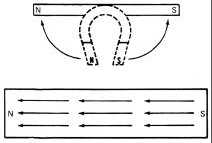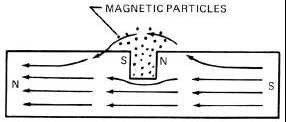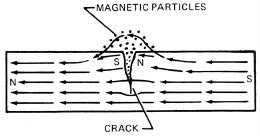T.O. 33B-1-1
3-5
3.1.6.2
Bar Magnet.
3.1.6.2.1
If the shape of the magnet is straightened, as shown in Figure 3-5, a bar magnet is created. The bar magnet has poles at
either end and magnetic lines of force that flow through the length of it and return around the outside of it. Magnetic
particles will be attracted only to the poles (in the ideal case). Such a piece is said to have a longitudinal field, or to be
longitudinally magnetized.
Figure 3-5. Horseshoe Magnet Straightened to Form a Bar Magnet.
3.1.6.2.2
A transverse slot or discontinuity in the bar magnet that crosses the magnetic flux lines will create north and south
poles on either side of the discontinuity (see Figure 3-6). The resulting leakage field will attract magnetic particles. In
a similar manner, a crack, even though it is very fine, will create magnetic poles as indicated in Figure 3-7. These
poles will also produce a leakage field that can attract magnetic particles. The strength of the leakage field will be a
function of the number of flux lines (i.e. the strength of the internal field), the depth of the crack, and the width of the
air gap at the surface. The strength of this leakage field, in part, determines the number of magnetic particles that will
be gathered to form indications. Clear indications are found at strong leakage fields, while weak indications are formed
at weak leakage fields.
Figure 3-6. Slot in Bar Magnet Attracting Magnetic Particles.
Figure 3-7. Crack in Bar Magnet Attracting Magnetic Particles.





